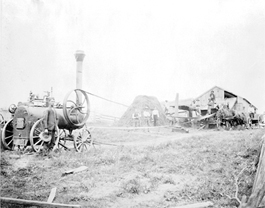| |
Yet horsepower as a measure of power pre-dates the mechanization of the farm. It was developed by James Watt in the 1780s as a way to measure the output of a steam engine. Horsepower was based on his observations of how much work a horse could do in a normal ten-hour day, pulling the sweep arms of the horse-powered pumps that were used to remove water from mines. This figure worked out to 33,000 foot-pounds per minute, or the effort required to raise 33,000 pounds of water one-foot in one minute.
As farmers mechanized barn or farm yard work like threshing, winnowing, corn shelling and corn grinding, they began to use stationary power sources—either treadmills and sweeps powered by horses, or steam engines. Here, the agricultural idea of horsepower and the industrial idea of horsepower bumped heads. A steam engine, such as the circa 1857 Owen, Lane & Dyer in our new Agricultural Gallery in Greenfield Village is rated at ten horsepower. The circa 1900 Heebner two-horse tread power uses, well, two horses. Yet each of these power sources could be used to run the same piece of farm equipment. Some farmers came to use a rule of thumb for farm equipment, calculating that one horse was worth about three horsepower in an engine. Why is this?
Engine horsepower ratings (and there are many varieties of these) are typically over-estimated because they are often calculations of the power delivered to the machine—not how much actually reaches its “business end.” For example, they don't account for power losses that occur between the piston, and whatever the piston is driving—which can be more like 70% to 90% of the rated horsepower. In addition, those measures are made at the ideal engine speed.
On the other hand, various studies have shown that peak horsepower for a horse (sustainable for a few seconds) is as high as 12-15 horsepower. This is based on calculated estimates, as well as observed estimates (a 1925 study of the Iowa State Fair's horse pull). Over the course of a 10-hour workday, however, the average output of a horse is more along the lines of one horsepower—which coincides with James Watt's original way of describing horsepower.
So how much horsepower comes from a horse? As we see, it depends. If we measure it in an optimal way, as we do with engines, it is as high as 15 horsepower. If we measure it as James Watt did—over the course of a long 10-hour day, horses walking in a circle—it gets down to one horsepower.
Nineteenth century farmers quickly learned that if they were buying an engine to do a task that a horse had previously done, they needed an engine that was rated for three horsepower for every horse they had used for the task.
-- Jim McCabe, Acting Curator of Agriculture

|
 |
| This March 1860 advertisement from Country Gentleman magazine shows a thresher-separator powered by a two-horse treadmill horse power. A steam engine could also have been used to operate the machinery. |
A portable steam engine powers the thresher-separator in this photograph, likely taken in the 1880s or 1890s. |
|

